Watering
Proper irrigation is critical to the crop. Most often, the plant is moistened with the onset of spring growth, during flowering.
Particular attention should be paid to watering when laying the buds. Then, water will be needed the most.
Humidification is carried out generously until water comes out in the pan. Excess moisture must be drained off necessarily, in order to avoid decay of the root system. The frequency of watering is best selected individually, focusing on the condition of the soil:
- It must be constantly wet.
- Do not allow it to dry out or stagnate water.
When the top layer of soil in the pot dries out by one third, this is a signal that watering needs to be repeated.
During flowering, it is important to ensure that no water gets on the petals and bracts. To avoid getting the flower organs wet, it is better to use a watering can with a long, thin spout.
When watering, it is directed to the inner wall of the pot, slightly lifting the hanging leaves. This will prevent water from entering the flowers.
After the end of flowering, the intervals between irrigations increase. During this period, the plant needs less water. With the onset of autumn, when the plant prepares for a state of dormancy and enters it, medinilla is watered the least. This regime is maintained until the end of winter. With an increase in daylight hours and an increase in temperature, the frequency of watering increases. If during this period, due attention is not paid to irrigation, the color organs will not form. Lack of moisture is one of the reasons why there is no flowering.
If tap water is used, it must be allowed to stand in an open container for at least three days. This measure is necessary so that chlorine evaporates and heavy lime salts settle. If after settling a precipitate has formed, it must be filtered.
6 Reproduction
Seeds or cuttings are used to grow new plants.
Reproduction of medinilla using seeds requires a lot of time, patience, and strict adherence to the rules of agricultural technology. Seeding begins after the end of the winter season. The seeds are placed in flat containers with a sand-soil mixture (1: 1). They are kept in a warm place at a temperature of at least + 28C. When shoots appear, they are seated in separate pots and continue to be kept in conditions of high humidity and temperature. In late spring - early summer, rooted shoots are moved to larger containers. Pinching the top is done. A young plant will bloom in 5 years.
A much more convenient and less laborious method of planting medinilla using cuttings. They can be obtained by pruning an adult plant. The seedling must have at least three buds. Planting takes place in early spring. Greenhouse conditions are created for the planted shoots (temperature + 26-30C) so that they take root faster. Landing is carried out in a container with sand. After a month, young plants have a root system. They need to pinch, provide feeding and watering.
Description of the plant
Medinilla is a numerous genus of tropical plants, which include herbaceous vines, shrubs and trees. You can meet them on all the islands of the Pacific basin, as well as on the coasts of Africa, Australia and India. The medinilla flower has a fibrous, highly branched root system. Growth height ranges from 30 cm to 2 m.
Ribbed greenish-brown stems occasionally covered with bristles. Large leaves with a solid edge have a dense leaf blade. In the center there is a relief vein of a lighter color, from which 3-9 smaller veins depart. Bulky leaves are arranged opposite or whorls. They are colored dark green.
















Medinilla inflorescences, which bloom in the spring, attract the most attention. They are located at the tops of the shoots and in the axils of the leaves.
Long drooping or erect pedicels grow below the main part of the crown. Miniature tubular or bell-shaped corollas are collected in dense brushes. They are surrounded by larger bracts, which fall off soon after flowering begins. Delicate buds are colored pink, purple or salmon. The lush pith consists of elongated stamens with bright anthers and an ovary.
After pollination, pear-shaped or oblong berries with many seeds ripen. The small seeds are covered with a smooth brown skin and are wedge-shaped.

Types and varieties
This tropical plant in natural nature has more than 350 varieties. Not all species have adapted in the European climatic zone. Domestic breeders identify several of the most popular types of medinilla.
Magnificent (magnifica, beautiful)
An evergreen shrub, the height of which in nature can exceed 150 cm. The homeland of this variety is the Philippine Islands and the territory of Indonesia.
The size of the dark green leaf plate exceeds 25 cm. Straight and fleshy branches grow from scaly internodes. The maximum length of one inflorescence can be 30 cm. The bracts around the small bells are pale pink in color. The plant prefers a climate similar to a tropical one.
This species has several popular varieties.
- Dolce Vita is a plant with bright pink inflorescences, around which you can see several thin bracts.
- "Trizor" is an unusual variety that lacks bracts, and inflorescences with cone-shaped petals have a blue tint.
- "White" is a beautiful variety with red inflorescences and short petioles.
- Flamenco is a highly decorative variety that forms deep pink inflorescences. The maximum flower height in natural nature reaches 50 cm, and the size of one brush is 30 cm.
Veined
Partially epiphytic species, which has a thin shoot in the form of tubes covered with scales. The shape of the green leaves is oval with sharp edges, the maximum length is 25 cm. There are 7 veins on the upper side of the leaf plate. The color of the tubular flowers is white.
Cuming
Low appearance, characterized by ovoid leaves with a sunken surface. The length of the leaf plate is 30 cm.The size of the pink corolla is about 6 cm.
Javanika
An unpretentious view that feels comfortable in the European climatic zone. The leaf plate is green and oval in shape. A characteristic feature is the absence of bracts and the presence of deep purple flowers.
For home cultivation, biologists recommend paying attention to medinilla sedum. This species is intended for cultivation in terrariums and florariums.
The plant is small in size, and the maximum length of the stems does not exceed 17 cm. The leaf blade is smooth and leathery. In each sinus, pink flowers are formed with a length of no more than 15 mm. A characteristic feature is the absence of bracts.
Plant care
The first requirement for the optimal existence of a flower is a high air humidity at + 20 ... + 22 ° С in the room. Humidity should be maintained throughout the year. For this, special devices are ideal, which are placed in the room and with the help of them humidify the air.
With such indicators, there may be a high probability of the appearance of fungal diseases. To avoid this, it is worth regularly ventilating the room, but not creating drafts, which plants are so afraid of. In winter, the temperature in the room drops to + 17 ... + 18 ° С, the humidity should also be reduced. Pots and flowerpots with medinilla are placed away from heaters and batteries, in order to avoid drying out of foliage and soil.
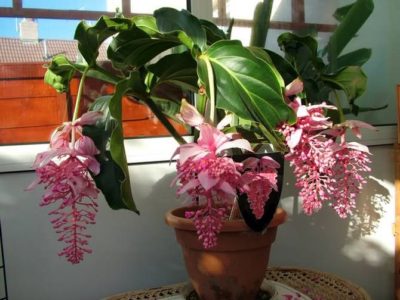
Watering a young plant is moderate.Although this species loves moisture, excess in the soil can lead to diseases of the root system. The indicator for irrigation is the soil, in which the top layer should dry out by 3-4 cm. Complete drying out of the soil and the formation of crusts should be avoided. Watering a medinilla flower is worth soft, settled or even boiled water at room temperature. Moisten it under the root and try to avoid water getting on the foliage.
Types of medinilla
Medinilla venous (Melinilla venosa)
Medinilla cumingii Naudin
Medinilla beautiful (Medinnilla magnifica)
Medinilla home care
It is advisable to buy medinila in the spring. The regal plant individual who settled in your house is very picky about growing conditions. Medinilla does not tolerate drafts, it is advisable to protect it from temperature extremes. In the summer you need to shade from the bright sun, and in the winter you need to provide good lighting. It is better to water your sissy with warm water, abundantly during the flowering period in spring and summer, water moderately after flowering, and during the rest period, less watering is needed. It is also necessary to maintain high air humidity through frequent spraying. Regular spring pruning will help to give the bush a beautiful shape.
Medinilla reproduction
You can propagate medella:
- Cuttings. In this case, each prepared specimen in 2-3 knots must be kept in a growth stimulator and buried in a wet mixture of sand and peat. Place in a warm, dark place. Roots will appear within a month.
- Layers. Less troublesome way. On the twig, you need to make an incision with a clean knife, wrap it with wet moss, pre-soaked with a stimulant for root formation, wrap it with foil. After the formation of roots, separate the process and plant in light fertile soil.
- Seeds. In early spring, sow the seeds in flat pots with a mixture of sand and leafy soil, place in a warm place. Medinilla from seeds pleases with its shoots by summer, then the seedlings are transplanted and care is performed as for an adult plant.
Medinilla pests and diseases
Medinilla care for her allows you to keep the plant in good condition, which increases resistance to disease and better resistance to attacking pests. The primary danger to the plant is mealybugs. They appear on the leaves during a hot period or from stagnant water. Sometimes there is a lesion with a scabbard and a red spider mite. Medinilla her diseases can spread quickly, so it is necessary to immediately begin to fight pests. At the first signs of the disease, wash the affected areas with soapy water, and then, if necessary, treat the plant with chemicals.
How to choose medinilla in the store
The best time to buy is summer and early fall. Approach the purchase very responsibly. Medinilla is an expensive flower, in case of an unsuccessful purchase, you will be sorry for the money spent in vain
Therefore, carefully inspect the stems and leaves of the plant you like, and also pay attention to the stem. It should be green, without any spots.
If you see spots, punctures, traces of pests, dry tips, weak shoots on the stem or leaves - refuse to buy. If you get a sick plant infected with fungus or insects, it will not be easy to cure it.
If you did not find any flaws and you are satisfied with the size of the selected copy, feel free to buy it and go home.
Florists often complain that two to three weeks after buying their medinilla got sick and died. Most likely, the flower did not survive a series of changes in conditions of detention. Perhaps he was recently brought to the store, he has not yet had time to adapt there. Then you bought him, brought him home and gave him a new place to live. The flower could not come to terms with this and died.We advise you to buy those specimens that have been in the store for quite a long time (about a month), have adapted to its conditions and have remained vigorous, healthy and attractive.
Transfer after purchase
Place the flower in a pre-selected location for 2-3 weeks to adapt. Then you need to transplant the flower from the shipping pot into the permanent pot you have prepared. It should be 4-5 cm larger.
- Wash off medinilla leaves with warm water that may have been used in the store before selling.
- Gently remove the plant along with the earthy clod. If the root system has grown firmly with the previous pot and is not easily pulled out, we recommend cutting the plastic pot with a hot knife so as not to damage the earthen lump of the plant.
- Place the lump in a new pot and cover with fresh soil. Follow all the transplant rules described above.
If you bought an adult bush that has a lot of leaves and flowers, then take care of supports, to which you carefully tie powerful stems so that they do not break off.
Is there an alternative?
Medinilla splendid is considered very capricious for growing outside greenhouses, but about 400 species of this genus are known in nature, and there are species that may be less luxurious, but less capricious. For example, try growing Medinilla javanensis. Unlike its excellent relative, it is less demanding on air humidity, a factor that significantly limits the possibilities of indoor gardening. At a young age, the plants are very similar, but Javanese medinilla grows faster and blooms in the third year after sowing (magnificent medinilla blooms only in the fifth year). She has equally beautiful large inflorescences of pink flowers, but no bright stipules. But Javanese medinilla easily sets seeds and pleases the owners for a long time with beautiful bunches of pink-blue berries.
Caring for medinilla at home
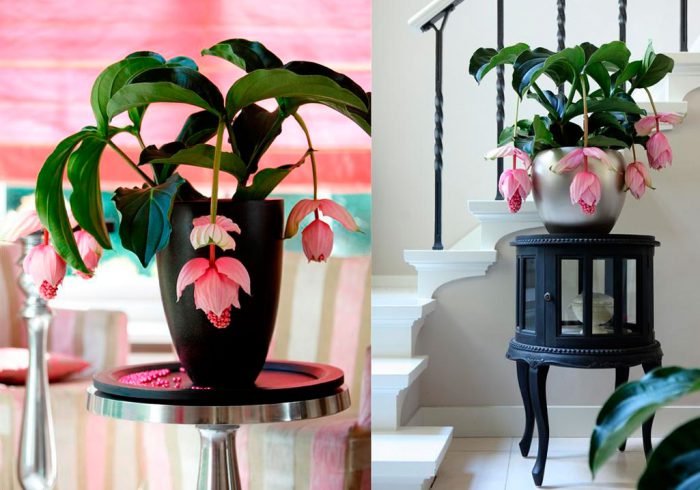
Temperature regime
This plant is very fond of warmth. In summer, the recommended temperature for its content is from 20 to 25 degrees. In winter, you need to make sure that the room where the flower is located is not colder than 16 degrees.
Illumination
Light-loving plant. It is necessary to choose a place with bright lighting, but at the same time you should not allow direct sunlight to hit the foliage.
How to water
During the budding of the plant, it needs to be watered abundantly enough. At other times, watering should be reduced to moderate. Water only with soft water, which does not contain lime. In winter, you need to water less. So, at this time, watering is recommended only after the leaves lose their turgor a little (that is, they become not so elastic).
It is also recommended to moisten this flower once a day from a sprayer. For this, well-settled water is used, which should be at room temperature. It is necessary to moisturize exclusively the foliage, while you need to make sure that moisture does not get on the bracts, as well as flowers.
Earth mixture
Suitable soil should be slightly acidic and light enough. To prepare a suitable soil mixture, it is necessary to combine peat, humus and coarse sand, which should be taken in a ratio of 1: 2: 1. Don't forget to make a good drainage layer at the bottom of the pot.
Fertilizer
You need to feed the plant only during the period of intensive growth. This procedure is carried out once every 2 weeks. Universal fertilizers for indoor plants are excellent for feeding.

Transplant features
It is necessary to transplant medinilla annually in the spring. This procedure must be carried out before the active growth of the plant begins, as well as before the budding begins. So, experienced florists recommend replanting a flower immediately after wintering at the very beginning of the spring period.
Reproduction methods
Most often, this plant is grown from seeds.However, sometimes cuttings left after the spring pruning of the bush are rooted. Rooting is recommended to be carried out in a mini-greenhouse, in which there must always be high air humidity and temperature (from 25 to 30 degrees). But you need to be prepared for the fact that such cuttings take root badly enough.
Pests and diseases
Mealybugs or spider mites can settle on the plant.
Medinilla is sick most often due to improper care:
Drying of foliage in winter - the room is too cold or too abundant watering. Increase the air temperature. Wait until the soil is dry before watering the plant.
Drying of foliage in summer - high temperature and low air humidity. Try to keep the room temperature below 25 degrees. Spray the foliage frequently.
Falling flowers and buds - due to cold drafts or as a result of moving the pot from place to place or turning it around its axis.
Pale spots appeared on the surface of the foliage - due to too bright light. Remove the plant in partial shade and provide shade from direct sunlight.
Lack of flowering - maybe as a result of improper maintenance of the flower during the dormant period
It is very important to adhere to all recommendations for the care of the medinilla at this time.
How to care for medinilla

This flower is not one of those that a novice florist can handle. Although you can find information on the Internet that it is rather unpretentious, but this is perhaps a tribute to advertising. To successfully keep a beauty in an apartment, you will have to put in a lot of efforts and skills.
Location and lighting.
We have already touched upon the information that medinillas are large plants that look harmonious in spacious offices, large halls or studios. In an ordinary city apartment, it is difficult to find a worthy place for an adult plant. In addition, keep in mind that they do not tolerate a rearrangement, a change of "place of residence".
Bright, but diffused light during long daylight hours is what a flower needs. Our heroine does not tolerate blackout, but she also does not like direct, hard sunlight, as befits real princesses.
Comfort temperature
It will be optimal if you provide a temperature of 20 to 25 ° during the active growing season. As in the case of lighting, deviations in one direction or another are perceived by the plant as painful.
After the medinilla has faded, starting from about mid-September, the temperature should be gradually lowered, so that in winter it will be at the level of 15-17 °. At this time, a period of relative dormancy begins for the plant, when it rests.
Air humidity
In this component, the flower is very difficult to please! The ideal humidity for him is 80%, which, of course, is almost impossible to achieve in an apartment, unless you have a large glazed greenhouse. In any case, strive to sustain at least 70%. To do this, use all available means: from a humidifier to a wide pan with wet expanded clay. Spray the crown with soft warm water as often as possible.
Watering and feeding
It should be regular, plentiful, but neat. It is desirable that the topsoil has time to dry out a little between waterings. Use soft, warm, well-separated water. Neither soil drying out nor water stagnation in it should be allowed. Both that, and another, will quickly lead to the occurrence of various diseases.
Least of all, the flower needs to be watered during winter rest, most actively - at the very end of winter and at the beginning of spring, when flower buds are forming and blooming.
Fertilizers are applied from March to the end of summer. It is advisable to feed it twice a month, using regular kits for flowering plants.
Soil features
The soil for medinilla needs to be prepared light, capable of being saturated with air and easily passing water.You can buy a ready-made soil mixture for epiphytic plants in the store, but if you make the substrate yourself, you should focus on the following composition:
- light sheet earth - 2 parts;
- sod land - the same amount;
- high-quality humus - 1 part;
- peat (preferably horse) - 1 part;
- coarse river sand - 1 part.
Planting and transplanting

Caring for medinilla at home involves regular plant transplantation. It is recommended to do this either in the fall, after the end of flowering, before leaving for winter holidays, or in early spring, even before the formation of flower buds. Considering that you are dealing with a very large plant, it is better to transplant every 2-4 years.
Always take the pot larger than the previous one, but not much. Make sure to provide a good drainage layer. The roots of the flower are tolerant of damage, so when transplanting, you can remove some of them along with the old soil.
The transplant should be combined with pruning. Remove dried inflorescences, cut out some of the old shoots. This will stimulate the emergence of new, young branches.
Top dressing
Mineral fertilizers designed for flowering indoor plants are well suited for feeding.
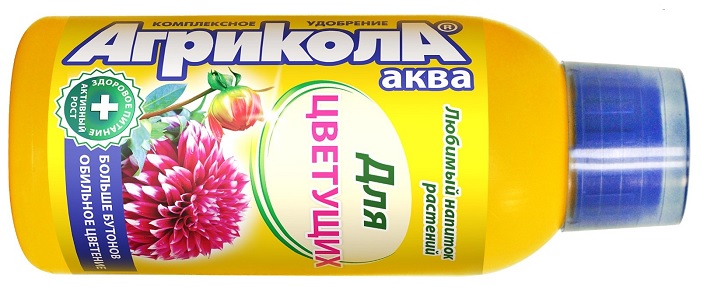 5.For feeding medinilla, you can use fertilizers for indoor flowering plants.
5.For feeding medinilla, you can use fertilizers for indoor flowering plants.
When choosing a brand, you should pay attention to the quality composition. He must meet the following requirements:
- The predominance of phosphorus-potassium compounds.
- The nitrogen content should be kept to a minimum.
Learn more about why these nutrients are so important and their percentage in the formula:
| Element | Nitrogen | Phosphorus | Potassium |
| Role in plant processes | Stimulates the growth of green mass. From a large amount of the element, many leaves are formed, which take away all energy resources from the plant, to the detriment of the formation of flower organs. With an excess of nitrogen compounds, there is no flowering, even if it is grown under ideal conditions for it. | Responsible for the condition of the root system, the formation of peduncles and buds. Also affects the quality and duration of flowering. | Strengthens plant tissues, performing a protective function, and also helps to retain and transport moisture. |
Thus, phosphorus and potassium should prevail in the composition of fertilizers for medinilla. Nitrogen is added in smaller amounts.
The frequency of feeding is greatest during the active growing season. From early spring to mid-summer, fertilizers are applied every 10 days. After flowering, the intervals increase to two to three weeks. At this time, nitrogen is completely eliminated.
From autumn to spring, top dressing is applied no more than once a month. And in December and January, they can be abandoned altogether, since the plant arrives in a state of deep dormancy and does not need replenishment.
Description of the plant
Medinilla is a perennial, tall shrub. Madagascar is considered his homeland.
The history of medinilla begins with the birth of the Spanish Empire in Oceania. For the first time, the plant was discovered by one of the heads of the colonial power J. de Medinilla y Pineda. In whose honor the flower was named. The shrub was introduced to Europe by the English nobleman Veich in the middle of the 19th century. After that, it began to be cultivated in different countries.
Description of the plant:
- The shrub is voluminous, but compact.
- Height - 2 meters or more.
- Stems are rounded or ribbed, hanging downward. Due to the small number of leaves, they appear bare.
- Flowers - unusually beautiful, large, gathered in panicles. Their length reaches 50 cm.
- The colors of the buds are varied. They can be white, light pink or red with no scent.
- Leaves are paired, whole-edged, with pointed ends.
- The plates are thickened, deep green, with 3-9 pink veins.
- Leaf location - 2-4 leaves extend from each node in opposite directions.
Medinilla is a whimsical plant. Taking care of her at home is quite difficult.Without observing certain rules for growing, the plant will die.
Varieties
There are several hundred types of medinilla in total. Most of them only grow in the wild. For home cultivation, the following varieties are considered the most common:
- Veinous. The ornamental shrub has thin, hairy, rounded stems. The crown is dark green in color. Leaves are embossed, with 7 veins, lanceolate, with pointed ends. Beige flowers are collected in small-flowered inflorescences.
- Gorgeous. Plant height reaches 1-1.5 m. Stems are erect, thick, shaggy. Foliage with a leathery surface, dark green, large, oblong-shaped. Flowers consist of small white-pink bracts and large bells.
- Cuming. The plant is not tall with spreading branches. The foliage is ovoid, deep green, slightly curved inward. The flowers are large, erect. The shrub blooms from March to May in pink.
As you can see, medinilla, unlike other flower crops, requires special care. However, using the above tips on agricultural technology, every florist can grow this ornamental plant.

Temperature
One of the most important factors in plant life. The heat-loving culture feels good in the range of +20 - +25, in the warm season. The spring-summer season coincides with the active vegetation of medinilla
During this period, it is important to provide uniform heat, without sudden changes in temperature.
At the end of February, beginning of March, with an increase in the length of daylight hours, it is necessary to set the heat to at least +20. This is necessary for the formation of young leaves and the establishment of flower buds. By the time the peduncles appear in April, the average temperature should be +22.
With the right lighting and heating, the plant starts flowering in mid-spring. Small numerous flowers open alternately. Each of them lasts about two weeks. The total flowering time is 1.5 - 2 months.
When the last bud withers, the temperature must not be changed. Uniform warmth is needed not only for flowers, but also for leaves. If you increase or decrease heating, the plant will react negatively to unwanted changes:
- The leaves dry out partially or completely.
- With a long-term negative influence, an extracurricular "leaf fall" occurs.
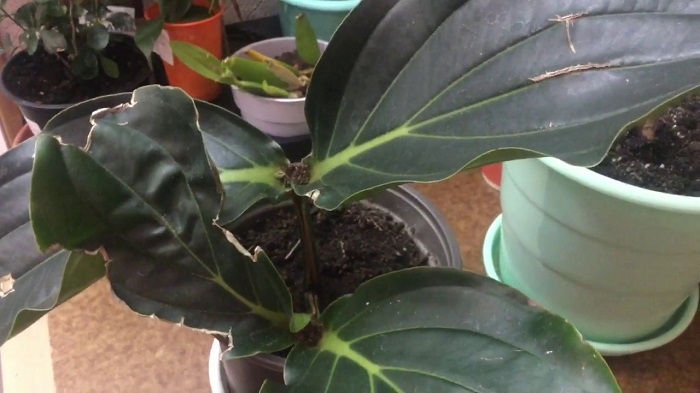 3. Medinilla leaves dry out from temperature drops.
3. Medinilla leaves dry out from temperature drops.
Gentle medinilla absolutely does not tolerate the slightest deviations from optimal performance. For a spectacular decorative effect of the leaves, you need to maintain the temperature until the end of summer, and preferably until September.
In the fall, when daylight decreases, the plant requires preparation for the winter period. At this time of the year, it enters a dormant state. In October, you can leave the leaves and move the pot to a cool place with a temperature of +18. It is not necessary to do this, the plant may well hibernate with plates. But, by all means, you must adhere to temperature changes:
From mid-autumn to the end of winter, it is important to ensure that the heat does not drop below +16. If medinilla is kept in the cold for a long time, she will die.
At the end of February, the temperature is raised to +20.
Photo medinilla





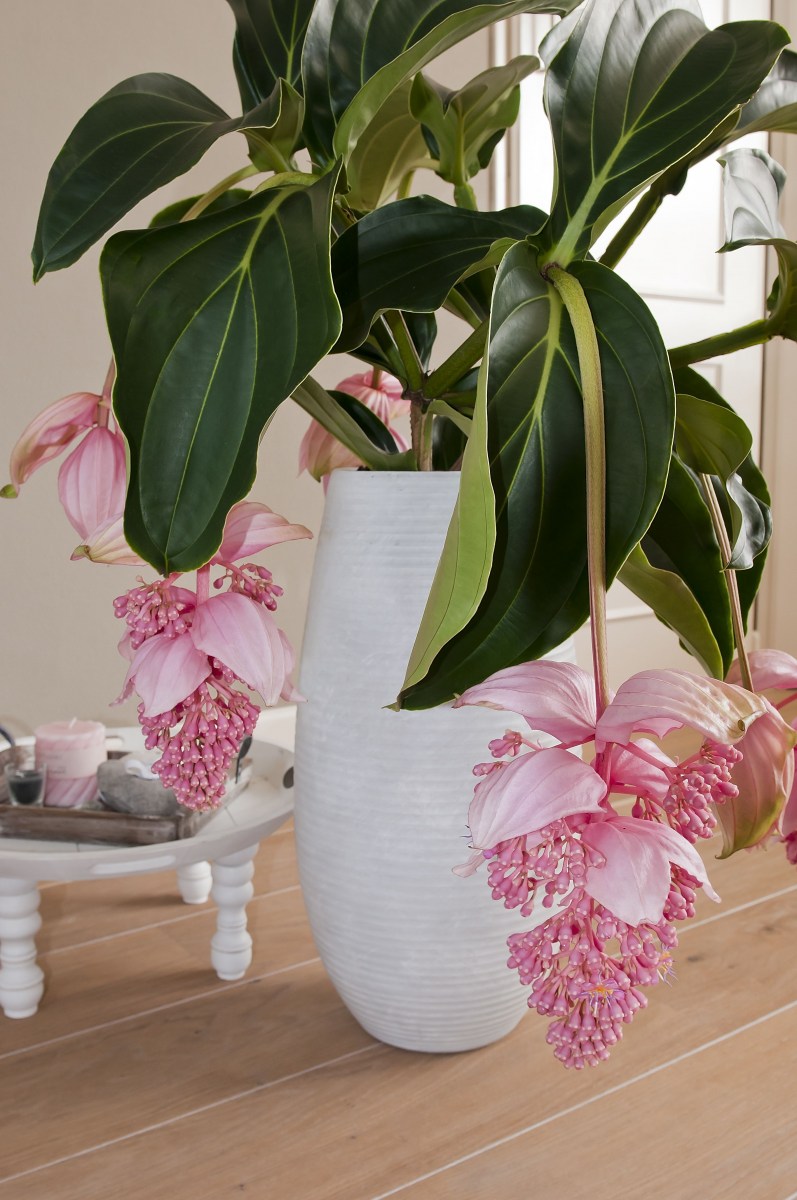







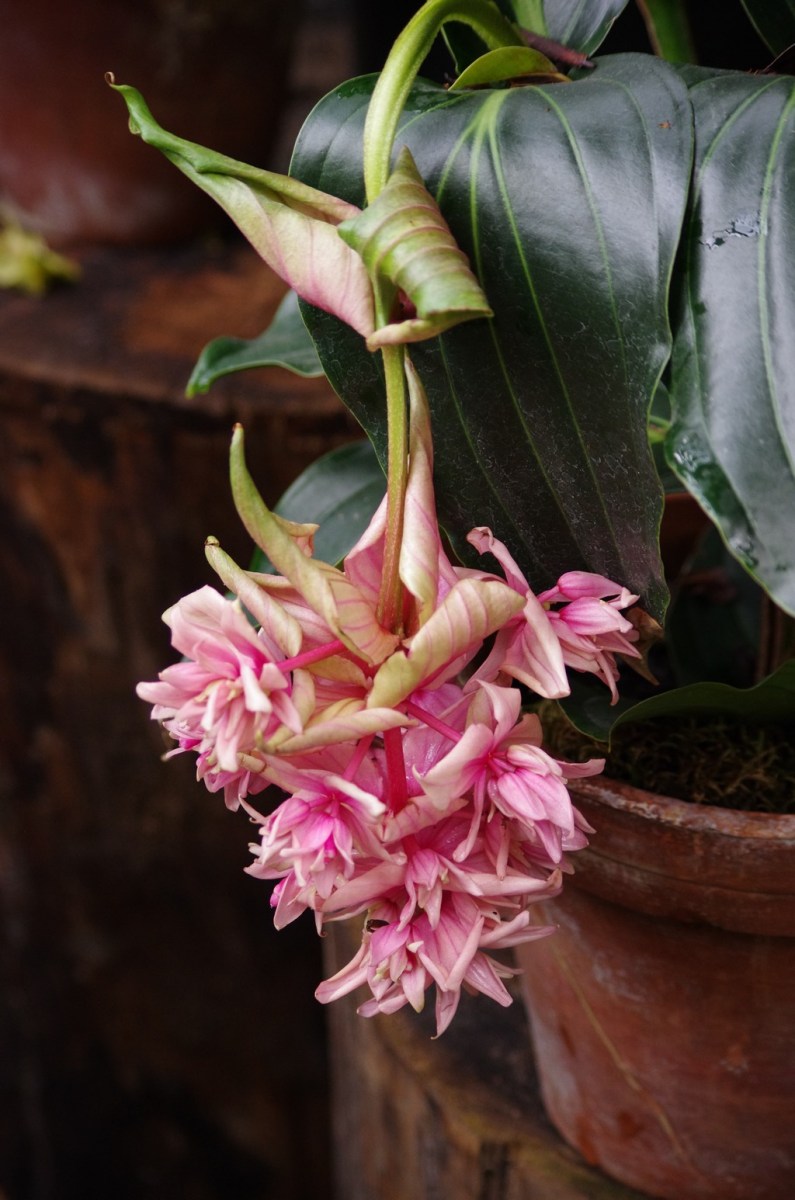


We also recommend viewing:
- Cyclamen
- Gerbera home
- Ahimenez
- Mimosa flower
- Indoor hydrangea
- Papiopedilum
- Eucharis
- Azalea
- Fuchsia
- Poinsettia
- Streptocarpus
- Pentas
- Indoor geranium
- Begonia Elatior
- Crossandra
- Spathiphyllum
- Saintpaulia
- Coleria
- Gloriosa
- Pachistachis
- Myrtle
- Indoor chrysanthemum
- Amaryllis
- Afelandra
- Kislitsa
- Abelia
- Ruellia
- Violets
- Abutilon
- Hippeastrum
- Tuberous begonia
- Pelargonium
- Indoor rose
- Gloxinia
- Agapanthus
- Takka
- Hypocyrt
- Katarantus
- Anthurium
- Lantana
- Primula room
- Strelitzia
- Hatiora
- Passionflower
- Clivia
- Home begonia
- Brugmansia
- Hyacinth
Transplant and soil selection
The transplant is initially performed annually, but upon reaching 3-4 years, the flower is transplanted every 2, or even 3 years. The root system is located superficially and is few in number, so the flowerpots are chosen shallow and wide. For a beautiful formation of the bush during transplantation, it should be cut off, removing dry stems and flowers. The substrate is best purchased in specialized stores, it should be designed for flowering plants and contain a low level of acid.

This type of plant is afraid of lime and salt soil. Some gardeners make their own soil at home, for this you will need:
- 1 part sand and peat;
- 1 part of sod land;
- 1 piece of leafy land;
- coconut fibers or sphagnum.
Loves epiphyte loose and well fertilized soil. Experienced flower growers warn that if the plant was in a different soil before transplanting, for example, in pine bark or in soil for orchids, then it should be transplanted into the land that is familiar to it.
Reproduction of the epiphyte occurs in two ways - this is cuttings and sowing of seeds. Of course, with the help of cuttings, breeding is faster and more efficient. To trim the cutting, an already stiff stem is selected and about three buds are counted. It is worth pruning in early spring. Next, the young stalk is placed in a greenhouse with sand. It is necessary to feed the seedlings with phytohormones and heat the greenhouse to 25 ° C. As a rule, the seedlings take root within a month.
But reproduction with seeds is performed at the end of winter. The grains are planted in special containers filled with coarse sand. As soon as young shoots appear, they are transferred to a mini-greenhouse and provided with constant heating. It is possible to wait for flowers from a seedling only after 5 years, not earlier, therefore, not many choose this method of reproduction of an epiphyte.
Indeed, this type of tropical representatives requires considerable care and some knowledge. Summing up, we can clearly highlight the main requirements for the care of medinilla, these are:
- room temperature not less than + 23 ... + 25 ° С;
- air humidity 70-80%;
- watering with soft, settled water;
- daylight hours up to 12 hours;
- the soil is slightly acidic, loose, fertile.
If you provide the necessary care for the plant, then it can perfectly exist and delight with its beauty for many years. Under ideal conditions, this flower can reach a height of about 1.5 m in a house.
Diseases and pests
Medinilla is distinguished by strong immunity, but if the substrate is excessively moistened, it can suffer from rot, and during drought it can be affected by worms. The flower can become infected from other indoor plants or react painfully to irrigation or lighting irregularities.
| Diseases / pests | Symptoms | Prophylaxis | Control measures |
| Gray rot, or botrytis | Dark spots appear on stems and leaves. | Avoid excessive soil moisture, strengthen plant immunity, fertilize in time. |
|
| Schervets | White lumps appear on the surface of the leaves. Sucking insects retard plant growth, cause yellowing and drying of leaves. | Maintain high air humidity - it inhibits the development of parasite colonies. |
|
| Spider mite | Yellowish dots form on leathery leaves. The plant dries up. | The pest loves the heat - in order to prevent it, it is necessary to irrigate the leaves with warm water. |
|
| Shield | It sucks the sap from the plant, depletes it and leads to yellowing. | Inspect plants periodically for parasites. |
|
| Aphid | Eating on sap leads to leaf lethargy and drying of the shoots. | Regularly inspect the flower garden for the presence of parasitic insects. Monitor the temperature regime, ventilate the room. |
|


